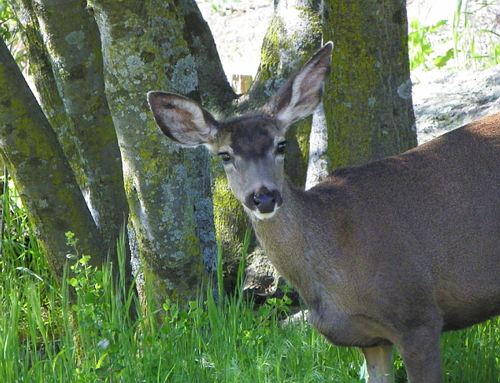
I’ve lived in Idyllwild for 13 years and only occasionally seen a lone deer on my morning hikes. Infrequently, we might see one bounding across Highway 243 on the way out of town. But, in the last few months, there has been an increase in sightings, not only in our Saunders Meadow neighborhood, but also in areas along the highway.
I’m spotting from three to eight deer nearly everyday, and not just in the early mornings or evenings. These animals, usually a doe or two accompanied by their yearlings, often appear meandering down the road in the middle of the day.
Shelly Kibby, park interpreter at The Nature Center, is seeing from three to five deer daily in the county park and agrees that this is a considerable escalation over previous years.
She relates this to all the trees killed off by bark beetle infestation. As a result of this reduction in canopy, large expanses of ground have received more sun, increasing the area of grasslands and providing additional food for the deer.
Kevin Brennan, Idyllwild resident and biologist for the California Department of Fish and Game, offers more information about our Southern mule deer population. He concurs with Shelly’s explanation and says that, while we are seeing more deer in our area, in general their numbers actually have not changed.
During the month of October, we might notice more deer as they take refuge during hunting season. Males can be more visible during mating or rutting season, which began the week before Thanksgiving and goes through mid-December. They become a little less cautious during this time.
Brennan reports that deer are both grazers and browsers, depending on the time of year and what is available to them. They feed on the first early Spring greens that usually appear in February and March. Then, they switch to a forbs’ diet, which consists of broad-leafed herbaceous plants that are higher in protein, in preparation for giving birth and lactation. Later in the year, the deer browse on leaves, stems, and twigs. Mule deer do not have any upper teeth, just a hard palate.
One of Brennan’s most interesting points is the role fire plays in the size of the deer population. Wildfires create the conditions most favorable to the kind of vegetation deer require for prime nutrition. With an emphasis on fire suppression in recent decades, the overall population has declined.
The life span of Southern mule deer in the wild is from nine to 11 years.
Speaking for the animals, if I have a message for all of us in presenting this information, it is to drive more consciously, conscientiously and cautiously on our winding roads. We have more than the lives of squirrels to safeguard.










